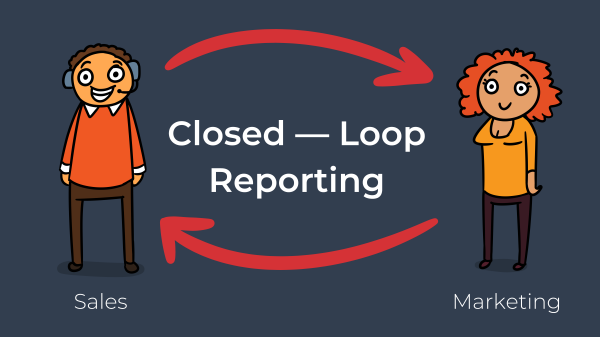
Traditionally, there has been a disconnect between marketing and sales teams in business. The marketing team is concerned with generating leads while the sales team focuses on turning those leads into paying customers. Neither department usually has any insight into each other’s data, leading to a lack of cohesion. This is where closed-loop reporting comes in.
What is closed loop reporting?
In a nutshell, closed loop reporting fills the gap between marketing and sales data. As a result, both teams are able to focus on marketing channels that deliver maximum ROI.
Typically, marketing teams collect data about leads using marketing automation systems i.e. Hubspot and analytics software such as Google Analytics. Sales teams, on the other hand, use CRMs such as Zoho to turn leads into paying customers. Each team only has information about half the marketing funnel.
Closed loop reporting gives marketing teams valuable insight into which channels bring in the most qualified leads. From there, businesses can increase their focus on the most effective marketing channels.
How does closed loop reporting work?
It all starts with the visitor and how they got to your website. When a new visitor arrives, a cookie is uploaded to visitor. The cookie attributes the visitor to a source i.e. email, allowing you to know how each visitor entered your website.
Next, the cookie tracks visitor actions on your website i.e. pages visited, typical paths followed and actions taken.
As visitors navigate your website, they can submit information to capture forms that you have setup throughout your landing pages. At this point, they become a lead and you store this information in a CRM.
When the lead makes a purchase, CRM software is used to credit the sale to its original source i.e. email. The marketing loop is now closed.
From here, you can create closed loop reports that tell you which marketing channels generated the most customers.
What are the benefits of closed loop reporting?
Closed loop reporting benefits marketers by providing comprehensive information about the best and worst leads sources. From here, businesses can improve their overall marketing efforts.
Focus on the most effective marketing channels
Marketers that utilize closed loop reporting can allocate more resources to channels that bring in the most qualified leads. For example, if PPC generates more conversions per lead than social media, marketers increase their PPC spend and decrease resources dedicated to social media ads.
Validate your marketing efforts
When you implement a closed loop reporting process, you will be able to substantiate all your inbound marketing decisions with powerful data. For example, let’s say you have decided to drive more traffic to your website by blogging. Using closed loop reporting, you will have evidence about how many leads each article generated, as well as how many leads converted. From there, you can validate your marketing efforts and not rely on vague claims.
Gain 360-degree insights about your customers
A closed loop reporting systems enables you to track your entire customer journey throughout your website. As a result, you can track lead behaviour throughout your website, as well as create an ideal customer profile based on demographic data. From there, you can more effectively nurture leads by making informed decisions using these two sets of information.
Accelerate your sales cycle
Utilizing these powerful insights about your leads, you can decrease the amount of time it takes for them to convert. By identifying which content your leads engage with most, you can focus you can promote the right content to the most qualified leads.
For example, if more leads convert after engaging with email marketing content vs social media, you can focus on generating leads through capture forms placed throughout landing pages throughout your website. Then, you can re-target those leads through EDM campaigns.
Set realistic KPIs
When you close the loop between your marketing and sales data, you now have powerful insights about visitor-to-lead and lead-to-conversion ratios for all your marketing channels. As a result, you can set realistic targets with regard to how many new leads and customers you can expect per channel.
Lower your costs per lead
With comprehensive information about your inbound marketing efforts, as well as the ability to set realistic expectations, you’re able to lower your cost per lead. Utilizing the information you have about your customer profiles as well as their behaviour, you can utilize the most effective channels and content types to drive sales.
How you can implement closed loop reporting:
In order to gain 360-degree insights about your customers, you need to bridge the gap between Google Analytics and your CRM. You can setup closed loop reporting for your sales funnel by following three simple steps, using our app called GA Connector. With GA Connector, you’ll be able to see your Salesforce data in the reports you build using Google Analytics.
Here’s how you can implement closed loop reporting using GA Connector:
- Sign-up for a FREE 30-day commitment-free trial.
- Next, begin the setup process by selecting your chosen CRM and following the provided steps.
- Build powerful closed loop reports with comprehensive data on your leads and customers.’
Once you have completed these three easy steps, you will have access to comprehensive insights about your marketing ROI in your CRM. From there, you will be able to see exactly how effective each marketing channel is and make decisions about which channels to pursue.
Get started now and create powerful closed loop reports when you sign up for a free trial at GAConnector.com.



